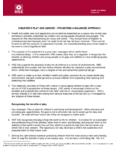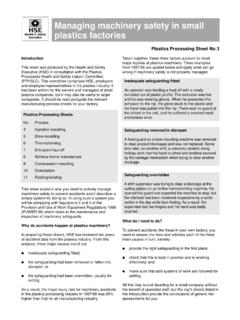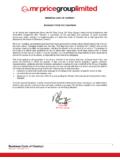Transcription of Guidance for safer working practice for those working with ...
1 Guidance for safer working practice for those working with children and young people in education settings 2015 Guidance for safer working practice for those working with children and young people in education settings October 2015 Acknowledgments: Adapted and updated by the safer Recruitment Consortium from an original IRSC/ DfE document and with thanks to CAPE (Child Protection in Education) 1 Contents Section Foreword Page 2 I. Definitions 2 II. Overview and purpose of Guidance 3 III IV Underpinning principles How to use the document 3 4 1. Introduction 5 2. Status of document 5 3. Responsibilities 5 4. Making professional judgements 6 5. Power and positions of trust and authority 6 6. Confidentiality 7 7. Standards of behaviour 8 8. Dress and appearance 8 9. Gifts, rewards, favouritism and exclusion 9 10.
2 Infatuations and crushes 9 11. Social contact outside of the workplace 12. Communication with children (including the use of technology) 10 11 13. Physical contact 14. Other activities that require physical contact 12 13 15. Intimate / personal care 14 16. Behaviour management 15 17. The use of care & control / physical intervention 15 18. Sexual conduct 16 19. One to one situations 17 20. Home visits 17 21. Transporting pupils 18 22. Educational visits 19 23. First Aid and medication 20 24. Photography, video and other images 21 25. Exposure to inappropriate images 22 26. Personal living accommodation including on site provision 23 27. Overnight supervision and examinations 28. Curriculum 29. Whistleblowing 23 24 25 30. Sharing concerns and recording incidents 25 2 Foreword The safer Recruitment Consortium s Guidance provides simple but detailed and practical advice to support schools and colleges and their staff in their safeguarding responsibilities.
3 I recommend schools, colleges and Local Safeguarding Children Boards consider using it in conjunction with DfE statutory Guidance - Keeping children safe in education when devising and implementing their safeguarding and child protection policies and training plans. EDWARD TIMPSON MP Minister for Children and Families Department for Education I. Definitions For ease of reading, references will be made to school and setting. This term encompasses all types of educational establishments including academies, independent and free schools, FE institutions, sixth form colleges and Early Years settings. References made to child and children refer to children and young people under the age of 18 years. However, the principles of the document apply to professional behaviours towards all pupils, including those over the age of 18 years. Child should therefore be read to mean any pupil at the education establishment.
4 References made to adults and staff refer to all those who work with pupils in an educational establishment, in either a paid or unpaid capacity. This would also include, for example, those who are not directly employed by the school or setting Local Authority staff, sports coaches. The term allegation means where it is alleged that a person who works with children has behaved in a way that has harmed a child, or may have harmed a child; possibly committed a criminal offence against or related to a child; or, behaved towards a child or children in a way that indicates they may pose a risk of harm to children. References are made in this document to legislation and statutory Guidance which differ dependent on the setting and alter over time. However, the behavioural principles contained within the document remain consistent, hence, wherever possible, such references have been removed in order that the document does not appear to quickly become out of date or to apply only to certain staff or settings.
5 3 II. Overview and purpose of Guidance This document is an update by the safer Recruitment Consortium of a document previously published for schools by DfES. It was initially issued as those working with children had expressed concern about their vulnerability and requested clearer advice about what constitutes illegal behaviour and what might be considered as misconduct. Education staff asked for practical Guidance about which behaviours constitute safe practice and which behaviours should be avoided. This safe working practice document is NOT statutory Guidance from the DfE; it is for employers, local authorities and/or LSCBs to decide whether to use this as the basis for their code of conduct / staff behaviour guidelines. The document seeks to ensure that the responsibilities of educational settings leaders towards children and staff are discharged by raising awareness of illegal, unsafe, unprofessional and unwise behaviour.
6 It should assist staff to monitor their own standards and practice and reduce the risk of allegations being made against them. It is also recognised that not all people who work with children work as paid or contracted employees. The principles and Guidance outlined in this document still apply and should be followed by any person whose work brings them into contact with children. The Guidance will also support employers in giving a clear message that unacceptable behaviour will not be tolerated and that, where appropriate, legal or disciplinary action is likely to follow. Once adopted, as part of an establishment s staff behaviour policy, the school or settings may refer to the document in any disciplinary proceedings. Whilst every attempt has been made to cover a wide range of situations, it is recognised that any Guidance cannot cover all eventualities. There may be times when professional judgements are made in situations not covered by this document, or which directly contravene the Guidance given by the employer.
7 It is expected that in these circumstances staff will always advise their senior colleagues of the justification for any such action already taken or proposed. All staff have a responsibility to be aware of systems within their school which support safeguarding and these should be explained to them as part of staff induction and in regular staff training sessions. This includes the school s child protection policy and staff behaviour policy (sometimes called code of conduct) of which this document will become a part. It is recognised that the vast majority of adults who work with children act professionally and aim to provide a safe and supportive environment which secures the well-being and very best outcomes for children in their care. Achieving these aims is not always straightforward, as much relies on child and staff interactions where tensions and misunderstandings can occur. This document aims to reduce the risk of these.
8 It must be recognised that some allegations will be genuine as there are people who seek out, create or exploit opportunities to harm children. However, allegations may also be false or misplaced and may arise from differing perceptions of the same event. When they occur, they are inevitably distressing and difficult for all concerned. It is therefore essential that all possible steps are taken to safeguard children and ensure that the adults working with them do so safely. III. Underpinning principles The welfare of the child is paramount 4 Staff should understand their responsibilities to safeguard and promote the welfare of pupils Staff are responsible for their own actions and behaviour and should avoid any conduct which would lead any reasonable person to question their motivation and intentions Staff should work, and be seen to work, in an open and transparent way Staff should acknowledge that deliberately invented/malicious allegations are extremely rare and that all concerns should be reported and recorded Staff should discuss and/or take advice promptly from their line manager if they have acted in a way which may give rise to concern Staff should apply the same professional standards regardless of culture, disability, gender, language, racial origin.
9 Religious belief and sexual orientation Staff should not consume or be under the influence of alcohol or any substance, including prescribed medication, which may affect their ability to care for children Staff should be aware that breaches of the law and other professional guidelines could result in disciplinary action being taken against them, criminal action and/or other proceedings including barring by the Disclosure & Barring Service (DBS) from working in regulated activity, or for acts of serious misconduct prohibition from teaching by the National College of Teaching & Leadership (NCTL). Staff and managers should continually monitor and review practice to ensure this Guidance is followed Staff should be aware of and understand their establishment s child protection policy, arrangements for managing allegations against staff, staff behaviour policy, whistle blowing procedure and their Local Safeguarding Children Board LSCB procedures.
10 IV How to use this document This document is intended only to be Guidance to schools and does not have any statutory weight. However, where statutory Guidance does exist in relation to a specific topic or practice , this is noted in the text. Each section provides general Guidance about a particular aspect of work and, in the right hand column, specific Guidance about which behaviours should be avoided and which are recommended. Some settings will have additional responsibilities arising from their regulations ( Early Years Foundation Stage (EYFS), Quality Standards) or their responsibility towards young people over the age of 18. Not all sections of the Guidance will, therefore, be relevant to all educational establishments. 5 1. Introduction Adults have a crucial role to play in the lives of children. This Guidance has been produced to help them establish the safest possible learning and working environments which safeguard children and reduce the risk of them being falsely accused of improper or unprofessional conduct.






